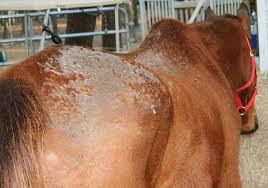Tuesdays with Tony
Dermatophilus congolensis
Spring is here, the flowers are blooming, the vehicles are covered in pollen, everyone is sneezing and boy oh boy the horses are shedding. The docs and techs around here are obsessed! They cannot stop themselves from scratching and rubbing and plucking out all the long tufts of hair the horses are losing. They claim it’s therapeutic, but I think it is just messy! The birds seem to like it, so I guess there’s that.
Now that spring is finally here, we’ve had some really warm days, and some rainy days as well. For horses who haven’t quite lost their winter coat, this can prove to be problematic, as they can develop the dreaded Skin Funk underneath all that hair. Take it from me, skin problems are no fun. Your horse is miserable with it, you are miserable trying to get rid of it and everyone around you is miserable because all you talk about is skin!
What is this skin funk?
Contrary to popular belief, that “rain rot” your horse has is probably NOT fungus. I know, I know, you’ve been around horses forever, and it’s always been fungus. Wrong! It has never been fungus. In fact, it has always been Dermatophilus congolensis. Maybe “fungus” is just easier to say, but Dermatophilus congolensis is actually a bacteria. The fun part about it is that the bacteria is naturally occurring on your skin. Most of the time it remains dormant and doesn’t cause a problem. However, when the environment changes, and all the stars align (which isn’t hard to do for Dermatophilus) the bacteria activates and proliferates.
Horses with long coats that get damp to the skin are significantly more prone to developing Dermatophilus. That’s why we see it so much this time of year. Any small breaks in the skin from an insect bite, a laceration or an abrasion allows the bacteria to enter the top layer of your horse’s skin. It then forms pustules that create scabs. These scabs are what you see and feel on your horse’s coat. They’re referred to as “paint brush” lesions because when you pull off the scabs, the hair comes with it and looks like a paint brush. I think they just look itchy and irritating, but I’m no artist.
While unsightly, irritating, and frankly just a pain in the rear end, Dermatophilus can be a rather mild infection. However, if left untreated it can become a much more serious bacterial infection such as streptococcus or staphylococcus. Strep and staph infections are significantly more difficult to treat, they are more painful, and can lead to systemic infection.
Symptoms and Causes
Symptoms of a Dermatopilus infection may include matted hair, small, crusty bumps on the skin, and hair loss. Your horse may be painful in heavily infected areas, their skin may be inflamed and there may be some pus-filled scabbing present.
The fun part about Dermatophilus is that it’s easily spread among horses. Sharing grooming tools, saddle pads, blankets, wraps, etc. are all very effective ways to spread the bacteria between horses in the same barn. Even just being in the same area as a horse with an active infection can cause the bacteria to spread to others. The good thing is, it’s not transmittable to people or cats! Remember, horses may have the bacteria on their skin in a dormant status, which means they’d have no signs but can still spread it to other horses that could develop the infection. Horses with an impaired immune system from stress, travel, illness, or malnourishment are significantly more susceptible to developing outward signs of infection.
Diagnosis
Diagnosing Dermatophilus is usually straightforward. The clinical signs are pretty clear. However, there are some other skin diseases that are important to rule out, including ring worm, parasitic infections, and other bacterial infections. This is done by several different means.
Skin impressions are an easy and inexpensive diagnostic tool that will confirm diagnosis based on clinical signs. A hair tuft is obtained and placed on a slide, mashed around, and then stained with special stain. The docs look at it under the microscope and if they see the classic “railroad track” bacteria, they know it’s Dermatophilus.
Another diagnostic tool my docs have up their sleeves is the skin scrape. Oh, heck no, you’re not coming towards this cat with a blade and the word ‘scrape’ in mind, nope, not going to happen. A skin scrape is performed using a dull surgical blade (don’t worry, it’s not previously used or anything) and my docs will make a small abrasion in your horse’s skin to get a sample of the deeper layers. They take this sample back to the clinic and look at it under the microscope as well. Rarely, they might find some little bugs (or mites) in the sample which would indicate an underlying problem causing your horse’s skin funk.
Treatment
Do me a favor: go in your tack room or wash rack or wherever you keep all of those expensive shampoos. It’s okay to cry a little, but those that say “anti-fungal” on them, they’re not going to solve your problem. You’ve spent a small fortune, I know. You probably could’ve sent your kid to college with the amount of money you’ve spent on different shampoos. You don’t have to dump all of those out, don’t worry. You can still use them for bathing at horse shows, or just for fun. However, they won’t be of use for treating Dermatophilus infections.
Since Dermatophilus is a bacteria, anti-fungal shampoos usually don’t contain the anti-bacterial properties necessary to kill it. Almost always, you’ll need an antibacterial shampoo that your veterinarian will prescribe. My docs love Kinetic Vet CK shampoo. They recommend bathing at least twice a week and allowing the shampoo to soak for 10 minutes each time. Occasionally, for very severe infections they may require more frequent bathing.
You might think, oh no! My horse has rain rot all over, I should go clip him right away. DON’T! Yes, it might seem like the easy fix, but it can cause small breaks in the skin allowing the bacteria easy entry and encourage spread. Same can be said for aggressive grooming. Don’t get me wrong, I’m all for an aggressive grooming. I love it, it’s like a deep tissue massage. However, very aggressive grooming can also cause small breaks in the skin, and when your horse has an active infection, it can be quite painful.
On rare occasions, my docs may recommend systemic antibiotics. Meaning medications that are given either orally or via an injection. Luckily, this usually only happens if the bacterial infection has progressed to a strep or staph infection. Similarly, my docs may recommend a topical antiseptic ointment to apply to any open abrasions to prevent the spread of bacteria.
Finally, and perhaps most importantly, do not share equipment between horses. Every horse should have his or her own brushes, saddle pads, blankets, wraps, etc. If you have to share, clean and clean often! Bleach is your best friend in this scenario. Soaking brushes in bleach water is a great way to get rid of the bacteria. Follow up the bleach soak by drying them in the warm sunshine. Bacteria hates dryness and sunshine. Wash your saddle pads and wraps after every use, and blankets, well, let’s just not share those.
Dermatophilus, if recognized and treated early, does not have to be the pain in the rear that we all know it to be. Horses recover easily and well from it. That being said, it can and will reoccur, so if you think you have a problem with skin funk, give my docs a call and have them come see your horse so you can come up with the best plan to manage that nasty bacteria.
Until next week,
~Tony
PS – You know the drill by now..be sure to take a listen to our Podcasts. Our docs work tirelessly gathering the best horse information out there. You can sign up on our podcats page right here. Also, did you know we have a YouTube page? We do, follow this link and catch one of our famous seminars. We have a few on Skin Funk.
Tuesdays with Tony is the official blog of Tony the Clinic Cat at Springhill Equine Veterinary Clinic in Newberry, Florida. If you liked this blog, please subscribe below, and share it with your friends on social media! For more information, please call us at (352) 472-1620, visit our website at SpringhillEquine.com, or follow us on Facebook!
[jetpack_subscription_form title="Subscribe to Whinny's Wisdoms"]


